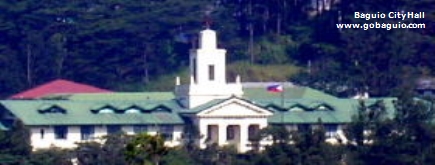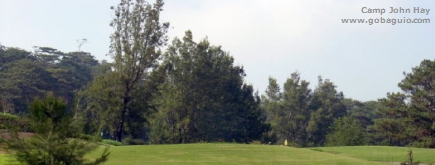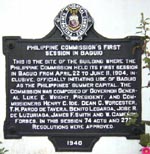 | ||||
General Information
A Brief History of Baguio City
The area now known as Baguio City was first called Kafagway and occupied by the Kankaney and Ibaloi tribes of the Cordilleras.
Spanish Occupation. During their occupation of the Philippines, the Spanish colonizers conducted a series of expeditions, led by Juan Salcedo in 1572 and Don Q. M. Quirante in 1694 to the cool mountains of Benguet.
A series of failed attempts
to conquer the natives
were made until foothold
was finally gained by Commandante de Galvey in 1846, when he was able to establish a commandancia or military garrison in a beautiful stretch of fertile flat land.
This he named after his wife, and is now known as La Trinidad. Galvey went on to establish the province of Benguet with 31 'rancherias' (camps or rural settlements). The area known as Kafagway was then a small rancheria composed of about 20 houses. La Trinidad remains the capital of Benguet province to this date. The 'presidentia' (civil government) was first established in the Guisad Valley area. It was later moved to the present site of the Baguio City Hall.
One of the notable contributions of the Spanish era was the introduction of coffee, of the arabica variety, which is still grown in this area and known as Benguet coffee.

American Occupation. When the Americans arrived in Baguio, after Spain ceded the entire Philippine islands to the United States of America for $20,000.00, they found the pine-covered hills and the cool heights ideal for retreats from the sweltering heat of the lowlands. In what was termed a "supreme feat of engineering" they carved Kennon Road from the mountains surrounding the Bued River Canyon, connecting Kafagway to the Pangasinan and Ilocos lowlands.

Japanese Occupation. After the Japanese attacked Pearl Harbor the war in the Pacific broke out and the Philippines, being the only colony of the United States, became a prime target. The Japanese bombed Baguio on December 8, 1941 and occupied it on December 27 of the same year, setting up their headquarters at Camp John Hay. However, the war eventually changed course and on September 3, 1945, General Yamashita formally surrendered to the Americans at the US Ambassador's residence in Camp John Hay, after which, Baguio immediately set to the task of rehabilitation.
Philippine Independence. When the Philippines was granted independence in 1946, Baguio City resumed its role as the Summer Capital of the Philippines, with Camp John Hay being retained by the Americans under the RP-US Bases Agreement.
Today, the city is the seat of the Cordillera Administrative Region (CAR), composed of the provinces of Benguet, Ifugao, Kalinga, Apayao and Mountain Province, and kept the monicker "Summer Capital of the Philippines."

This plaque can be found at the Baden Powell Inn on Gov.
Pack Road near the corner of Session Road. It reads:
"PHILIPPINE COMMISSION'S FIRST SESSION IN BAGUIO
This is the site of the building where the Philippine Commission held its first Session in Baguio from April 22 to June 11, 1904, inclusive, initiating use of Baguo as the Philippines' Summer Capital. The Commission was composed of Governor-General Luke E. Wright, President, and Commissioners Henry C. Ide, Dean C. Worcester, T. H. Pardo de Tavera, Benito Legarda, Jose R. de Luzuriaga, James F. Smith, and W. Cameron Forbes. In this Session, 74 Acts and 273 Resolutions were approved. 1940"
Quick Links
• Folks say
the city got its
name from
"Bag-iw" a mossy flowering plant that grew in these parts the American colonizers pronounced as
"Bág-ee-yow"
©2012. All Rights Reserved. GoBaguio! Your Complete Guide to Baguio City, Philippines
Early in 1900 the Americans established their government with H. Phelps Whitmarsh as the first civil governor appointed for the first provincial government established in the Philippine Islands, Benguet. At that time, the Philippines was still under the U.S. Military Government.
Baguio was then the capital of Benguet, and the American's best administrators and teachers were fervent boosters and promoters: Worcester, Wright, Forbes, Pack, Barrows, Eckman and others who together with Filipinos committed to make the place a virtual heaven on earth. It was set up as both a mining town and a recreational facility. The mountains surrounding Kennon were mined with camps erected from the base to the plateau that Baguio sits on. In 1903, Camp John Hay was developed for the rest and recreation of the U.S. Armed Forces.
Baguio City was designed by premier American architect and urban planner Daniel H. Burnham, who also master-planned Chicago's One Magnificent Mile and Manila's Roxas Boulevard. American missionaries came and "Christianized" the natives and English became the lingua franca.
On September 9, 1909, Baguio was declared a chartered city and the "Summer Capital of the Philippines" with The Mansion as the residence of the American governor-general during the summer to escape Manila's heat. The Philippine Commission held it's session in Baguio City, in the area on top of what is now known as Session Road.
Did you enjoy this page and find it useful?
SHARE!

GET EVEN MORE FROM US!
During summers, the whole of the Philippine Government conducted its business in the City of Pines, a tradition that is continued today only by the Philippine Supreme Court. This partly accounts for the ownership of a lot of beautiful vacation homes by the country's oldest families in areas like Leonard Wood Road, Park Drive and South Drive. Most of the prime property in Baguio City is owned by the national government: Cabinet Hill, Engineer's Hill, Supreme Court Compound, Court of Appeals Compund, Comelec Compound.
Baguio was the Philippines' top tourist destination from 1946 until July 16, 1990, when a 7.7 magnitude earthquake hit the city, after which it rebuilt quickly and all traces of the devastation removed.
Camp John Hay was turned over to the Philippine Government on July 1, 1991 simultaneously with the turnover of all U.S. Bases in the Philippines, and was, in turn, awarded to a private developer in 1997 on a long-term lease contract.
